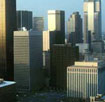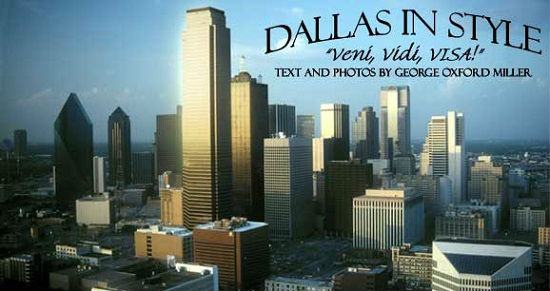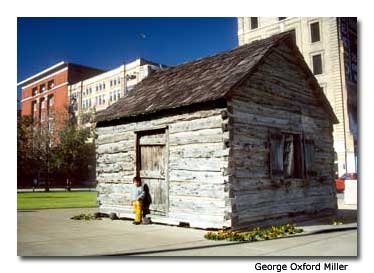

Don’t look for cowboys on the street corners in Dallas. After a day in downtown Big D, the only person I see wearing boots is a demure woman with the patent-leather, calf-high variety in Neiman Marcus style, the prestigious department store chain that got started here. Dallas doesn’t, and never did, go for the cowboy style. Think nouveau-rich oil money and you’ll get the Dallas image. It’s been decades since I grew up in Dallas, when Pegasus, the “Flying Red Horse” atop the Magnolia Oil Building, was the icon of the Dallas skyline. Now, Pegasus is lost in canyons of glass and steel skyscrapers, but the Dallas style remains the same as always.
Dallas is a tuxedo city of haute cuisine, art galleries, and exclusive shops, yet with enough unpretentious Texas tacky to make the Velvet Elvis Tavern a hip hangout. In a few blocks area, shoppers can find everything from thousand-dollar silk suits to air-brushed tee-shirts. You can break the bank in Neiman Marcus or barter with sidewalk vendors speaking broken English.
Two statistics epitomize Dallas: it has more shopping center space per capita than any other city and more restaurants per capita than New York City. After Dallas’ ingenuity created the first strip mall, Highland Park Village, which is still going strong (Mockingbird Lane and Preston Road: 214-559-2740; www.hpvillage.com), it gave the world two other 20th-century breakthroughs — the frozen margarita and chicken fajitas.
The best of Dallas begins in the heart of downtown. The Adolphus Hotel (1321 Commerce Street, 214-742-8200; www.adolphushotel.com) and its French Room Restaurant have represented the flagship of hospitality since 1912. The American Automobile Association (AAA) gives both five diamonds. A block away you can stroll through the original Neiman Marcus Department Store (1618 Main Street, 214-741-6911), sample a chocolate truffle (US$ 20/lbs), and have a gourmet lunch in the Zodiac Room.
For the signature Dallas dining experience, book a table at Antares in the rotating dome atop the 48-story Reunion Tower in the Hyatt Regency (300 Reunion Blvd, 214-712-7145; www.dallasregency.hyatt.com). At sunset, a golden glow splashes watercolor hues across the glass skyline. Or dine with the art crowd at Dakotas Steakhouse (600 N Akard St, 214-740-4001), known for the finest in seafood, grilled wild game, and homemade breads and desserts. An elevator on a pedestrian island across from the elegant Fairmont Hotel (1717 N Akard St, 214-720-2020) takes you below ground to the restaurant.
Downtown Dallas is also a haven for art enthusiasts. The Museum of Art (1717 North Harwood, 214-922-1200; www.dm-art.org), noted for its collection of modern Abstract Expressionist paintings and pre-Columbian and African art, crowns the 11-block Arts District. Across the street from the museum, the Trammell Crow Center (2010 Flora St, 214-979-6430) features a sculpture garden with 22 French bronzes and works by French sculptor Auguste Rodin. Just two blocks away, the glass dome of the futuristic Morton E. Meyerson Symphony Center (2301 Flora St, 214-670-3600), designed by I. M. Pei, arches over the skyline. Dallas also entertains theater lovers. The renovated Majestic Theater (1925 Elm Street, 214-880-0137) built in 1922, presents ballets and Broadway shows, while local actors perform at the Arts District Theater (2401 Flora St, 214-522-8499).
The towering downtown skyscrapers dwarf the vintage brick and granite buildings of a past era. Yet, amidst the glitz, Dallas carefully preserves its history. Pioneer Plaza captures the Old West in bronze. Three mounted cowboys drive a herd of 50 longhorns down a grassy hillside. The one-and-one-fourth life-size steers represent a sight common during the cattle-drive era of the late 1800s.
A few blocks away, Dallas dedicates the most expensive square block in town to a tiny log cabin. Juxtaposition against skyscrapers and bustling traffic, the reconstructed cabin (Historical Plaza, Downtown Dallas) commemorates John Neely Bryan, who founded the city on the banks of the Trinity River in 1841.

Across the street, the John Fitzgerald Kennedy Memorial brings back painful memories. Four stark walls surround a simple marble slab inscribed with the name of the fallen symbol of a generation. Immersed in memories, I read poignant notes, many written by people born years after the assassination, tucked among fresh bouquets of flowers.
My hometown pilgrimage continues a block away. I stand by the reflecting pool at Dealey Plaza and somberly count up to the square windows to the sixth floor of the Texas Schoolbook Depository (411 Elm St, 214-747-6660). The Sixth Floor Museum recounts the tumultuous events surrounding Kennedy’s assassination. It recaptures that moment in history with photographs, videos, and movies. Like many visitors, I stare out the window to the street below as though watching the motorcade slowly roll past the grassy knoll, then suddenly speed up and disappear through the triple underpass.
Leaving the museum, I stroll down Market Street through the West End Historic District with its Victorian lamp posts and red brick sidewalks. A horse-drawn carriage trots past as though time has slipped into a bygone century. Called “Froggybottoms” in the 1870s, the district’s frontier saloons and brothels attracted a rowdy clientele. Today, the cycle completes itself with the emphasis once again on entertainment.
The enticing aroma of barbecue and the good vibes of Dixieland jazz follow us step for step. Sidewalk cafés offer Tex-Mex, Southern, Chinese, and Cajun cuisine, as well as omnipresent fast food spots. For Texas barbecue at its best, I sample Sonny Bryan’s Smokehouse (2202 Inwood Road, 214-357-7120; www.sonnybryansbbq.com). The original establishment, about five minutes from Love Field, has been a Dallas legend since 1910.
The West End MarketPlace (603 Munger Avenue, 214-748-4801), an imposing seven-story, red-brick building, dominates the historic district. Built in 1922, the warehouse originally housed the Brown Cracker & Candy Company. Inside, the original maple floors and yellow pine beams impart a Roaring 20’s ambiance, and a five-story atrium with skylights brings the outside in.
Don’t look for New York fashions or candle-lit restaurants at the West End MarketPlace. Look for fun. This four-level, pizza-by-the-slice mall houses more than 70 stores. You can buy Texas wines, baseball cards, get a video portrait, graze in 30 eateries, dance to live music, take in a movie, play 36 holes of miniature golf, and disappear into a 100-game video arcade
After a day exploring downtown, I decide to escape the concrete corridors and hop a trolley. The McKinney Avenue Trolley, with vintage 1906 streetcars, links more than 100 galleries, antique shops, and restaurants (the trolley is free; 214-855-0006; www.mata.org). The trolley begins at the Museum of Art and runs for almost three miles (4.8 km) past the Hard Rock Cafe (2601 McKinney Avenue, 214-855-0007) and the Hotel Crescent Court (400 Crescent Court, 214-871-3200, also housing shops, restaurants, and galleries).
If serious shopping is your forte, the birthplace of the shopping center will challenge your credit limit. Neiman Marcus set the trend in haute monde shopping in 1907. Shopping centers such as the Galleria (I-635 LBJ at Dallas North Tollway, 972-702-7100) and NorthPark Center (8687 N. Central Expressway, 214-363-7441) continue the long-revered Dallas tradition of “Veni, Vidi, VISA.” Dallas teenagers feel like they’re slumming when they cruise malls in other cities.
As a stylin’ city, Dallas blends its 21st century glass-and-steel skyline with the profile of a rustic log cabin. With a history filled with both pride and shame, cows and culture, Dallas isn’t afraid to wear sneakers with its tuxedo.
If You Go
Dallas Convention and Visitors Bureau
800-232-5527
www.dallascvb.com
